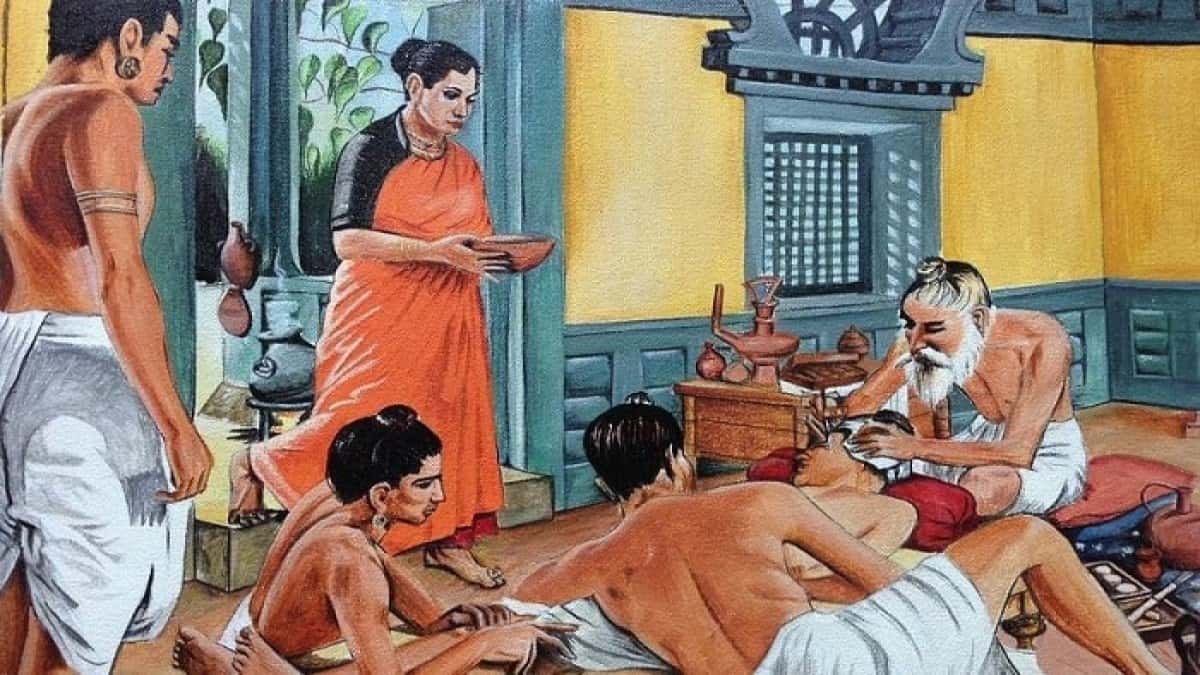Let’s talk about the development history of surgery. Columbia University School of Medicine once was referred to as “Columbia School of Physicians and Surgeons”, as it refers to the independent development of medicine and surgery, sometimes opposite each other. Even today, some surgeons in the UK use the title “Mr.” with great pride rather than defining themselves as a Doctor. They have already deserved it.
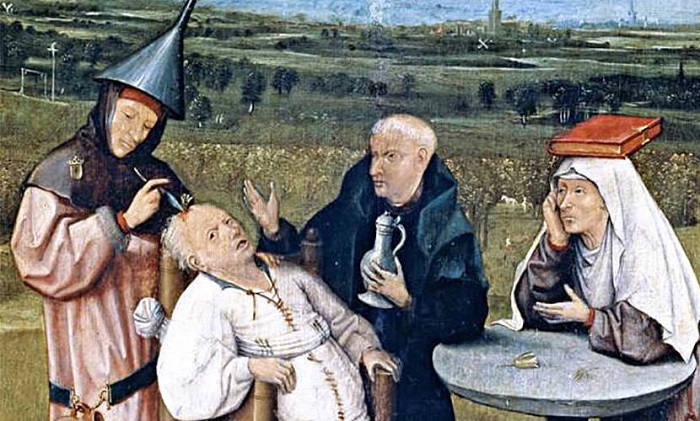
The first surgery performed on a human was probably done after the invention of cutting tools. Evidence of the first surgical intervention dates back to the Neolithic Age (10th to 6th century BC). Even the first brain surgeries date back as early as the 8th century BC. Trepanation, which was the process of piercing the skull with a surgical saw to reduce pressure on the brain, was a common technique even at that time. Any of the three skull bones (anterior, lateral, or posterior bone) of a living patient were taken out to reach the dura mater, the hard, fibrous membrane that forms the outermost layer of the brain. Although there were no pain prevention methods such as anesthesia or antisepsis, in these surgeries performed thousands of years ago, the chances of survival for the patient were quite high, unless the dura mater was damaged.
Until the 2500s BC, Egyptians successfully circumcised both men and women, as evidenced by their many carved works that have survived to the present day. They also performed various amputation operations (surgical cutting of various parts of the body) using the willow bark and leaves as a medicine against infection. Ancient Egyptian medical papyri give detailed instructions on a wide range of surgical procedures, such as how to fix a broken leg and sew up a big cut.
Hindus in ancient Indian civilization used surgical methods to remove bladder stones, tumors, and even sick tonsils and to treat a broken leg. But their biggest contribution to medical science is in the field of plastic surgery. The history of this surgery began in the Ancient Indian civilization in 2000 BC, when plastic surgery operations were so much needed because of the nose- or ear-cutting punishment imposed on criminals.
Sushruta Samhita, a text on surgery
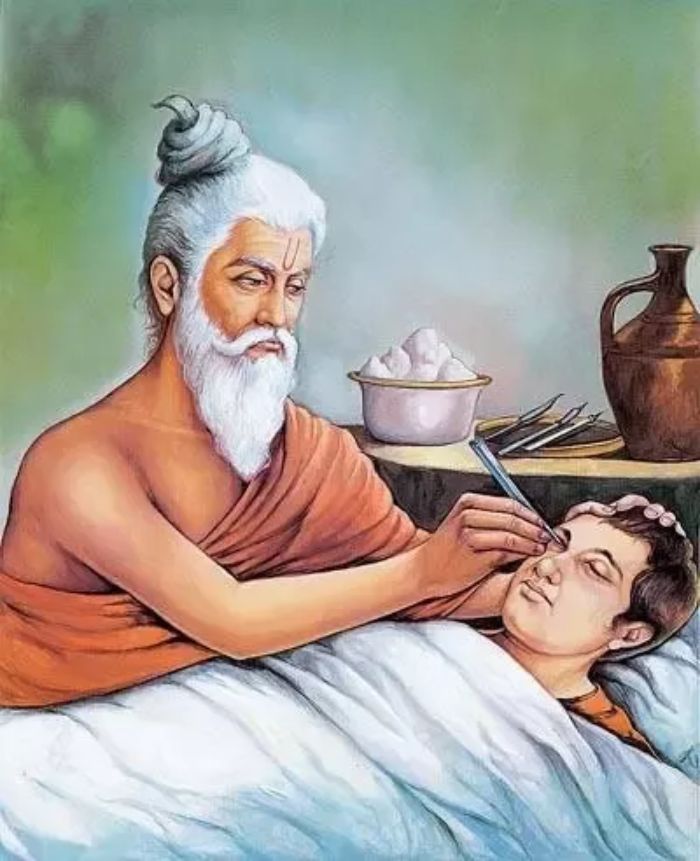
The surgical methods applied to people whose noses or ears were cut during these years were first described in a book named Sushruta Samhita. Sushruta had focused on nasal surgery but, surprisingly, also performed eye-related surgical interventions such as the removal of cataracts in the eye. In his book, he divided surgical interventions into seven categories; Chedya (excision), Lekhya (scarification), Vedhya (puncturing), Esya (exploration), Ahrya (extraction), Vsraya (evacuation), and Sivya (suturing). The following text is a section from the book:
When a person’s nose is cut or damaged, the surgeon takes a leaf of the plant into the shape and size of the damaged areas as a model. This leaf is placed on the patient’s cheek and a leaf-sized skin piece is taken from the cheek (but during this procedure, one side of the skin piece should remain attached to the cheek). Then, the cut edges of the nose are removed again and the piece of skin taken from the cheek is carefully closed over this damaged area and suturing is done from the edges. The physician then places two thin straws in the nostrils to facilitate breathing and prevent the sutured skin from collapsing. Then, apply licorice root and barberry powder in this area and cover it with cotton. When the sewn skin begins to grow with the skin of the nose, the physician completely cuts the skin from the cheek.
Sushruta Samhita
Corpus Hippocraticum, and Hippocratic Oath
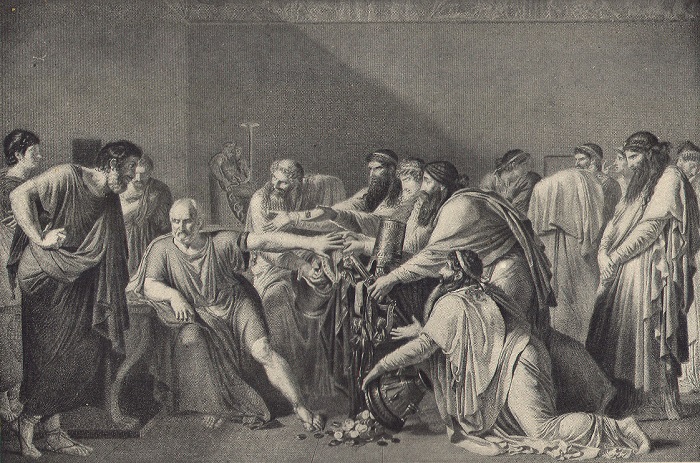
In the 4th century BC, the Greek physician Hippocrates made great contributions to surgery with his writings, which depict various surgical operations in detail. But these attempts always required courage and strength. The surgical instruments used at that time were made of iron, copper, or copper alloy. These rough tools were used to remove bladder stones as described in the Corpus Hippocraticum. But when we think of the Hippocratic Oath, which prohibits breaking the kidney stone with the words “I will not cut, even for the stone, but I will leave such procedures to the practitioners of that craft,” there is irony. The ancient Greeks inserted a hollow metal tube through the urethra to empty the bladder. This pipe, known today as the catheter, is made of straight copper for women and S-shaped copper or lead for men. This was a dangerous procedure that greatly hurt the patient, like all procedures performed at that time.
The philosopher Celsus says a surgeon must be vigorous. His intuition must be strong and sharp, and his nature must be brave; he must be merciful enough to treat his patient, but he must not be affected by his painful screams and rush his job. He must act as if he never heard the painful screams.
The barber surgeons
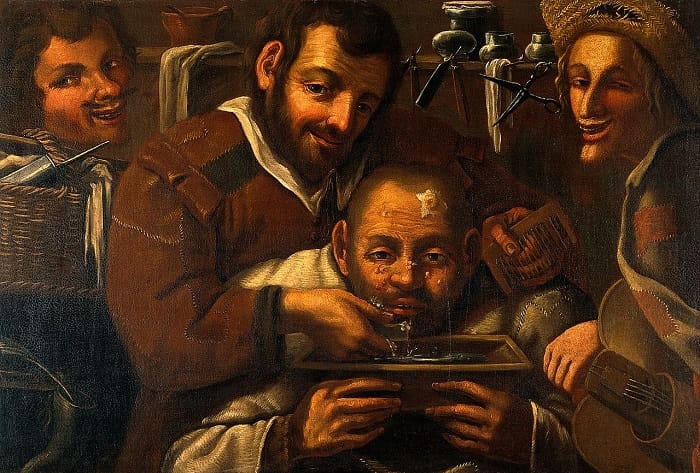
Before the Middle Ages (5th–14th centuries), surgery was considered a profession of the proletariat class. Between these centuries, surgeons were kept at a much lower level than trained physicians. Surgical interventions were performed only by barbers. For this reason, the field of surgery experienced a long period of stagnation during this period. It is interesting that during this period, the barbers who wandered from town to town were only trusted when they bled a patient’s blood in large quantities to remove a tumor in the body, pull a tooth, stitch cuts, and treat various diseases. The barber’s pole sign–a staff or pole with a helix of colored stripes–is from the period when barbering and surgery were not separated. At that time, the barbers shed the blood of the people to protect them from diseases, and the red strip was for the patient’s blood, the white strip was for the bandage wrapped around the patient’s arm, and the cylinder was the stick that was given to the patient.
The surgery is on the rise
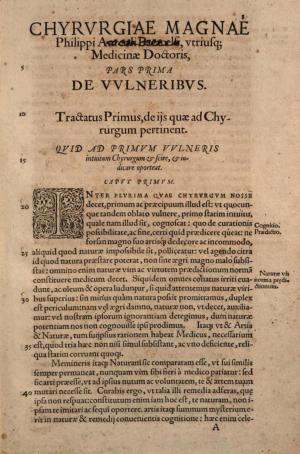
Until the French surgeon Guy de Chauliac wrote his great work “Chirurgia Magna” in 1316, there was no improvement in surgery. This work allowed surgery to regain respectability in Europe, if not the rest of the world. After three hundred years, both surgery and medicine have witnessed major developments. French surgeon Ambroise Pare developed the ligation method in which the vessels are tied to stop bleeding. The discovery of the ligation put an end to cauterization, an ancient method of cauterizing the wound with a hot iron or oil to stop bleeding. With a better understanding of how blood moves through the body and why capillaries are there, surgical procedures have become much more effective.
However, until the 1840s, surgeons rarely had the opportunity to examine the depths of the human body and tamper with vital organs due to the risk of infection and the pain the patient felt. Then, on March 30, 1842, medical doctor Crawford Williamson Long managed to remove one of the two tumors in the neck of a patient named James Venable, using ether as an anesthetic. This was the first time that anesthesia was used for surgical purposes in the history of medicine. However, Dr. Long’s failure to publish the successful results of his work until 1848 caused William Morton, who worked in the same field, to collect praise for this great invention.
The birth of modern surgery
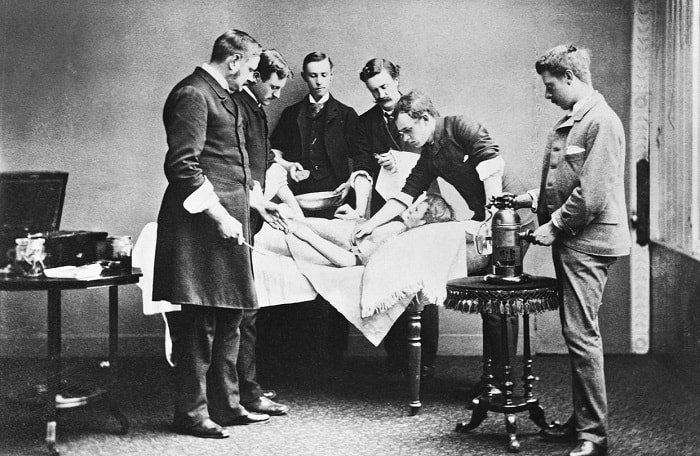
By minimizing the pain felt in surgical interventions, the only obstacle that was preventing surgery from being a complete revolution and remedy for the treatment of numerous diseases was the risk of infection. Louis Pasteur’s discovery that fermentation or decay was caused by bacteria in the air was the first step toward the understanding of infection. With British surgeon Joseph Lister’s innovation of antiseptic surgery by applying Pasteur’s findings in 1865, modern surgery was born.
Lister developed a series of antiseptic products with carbolic acid spray in order to provide hygiene in the operating room. Today, the mouthwash named “Listerine” is named after him. Australian physician Ignaz Semmelweis and American physician Oliver Wendell Holmes later improved the hygiene sensitivity in medical practices and insisted physicians wash their hands and wear clean clothes just before the surgery.


